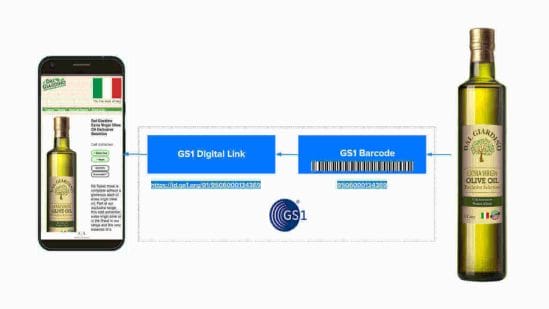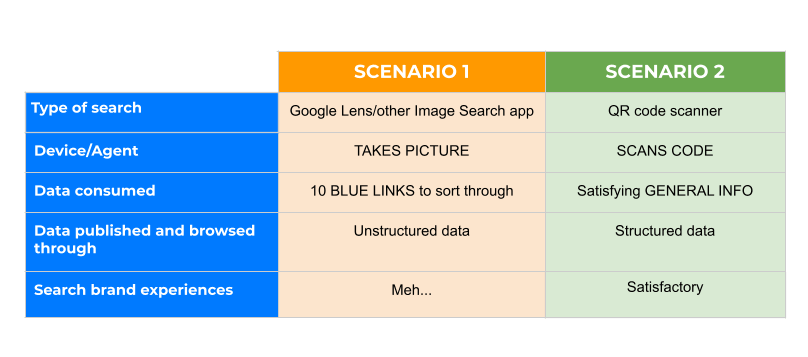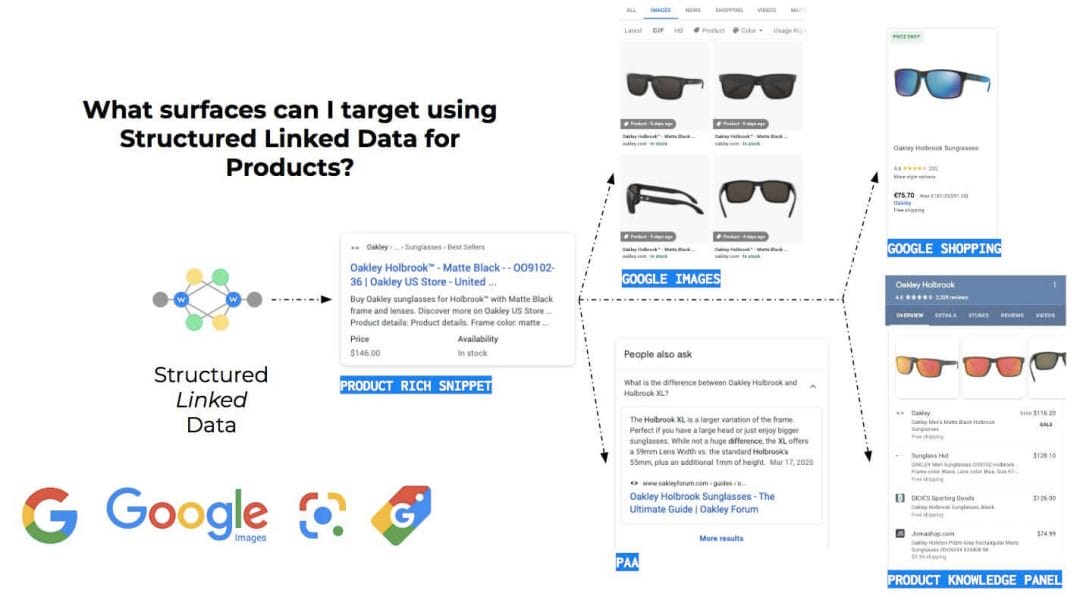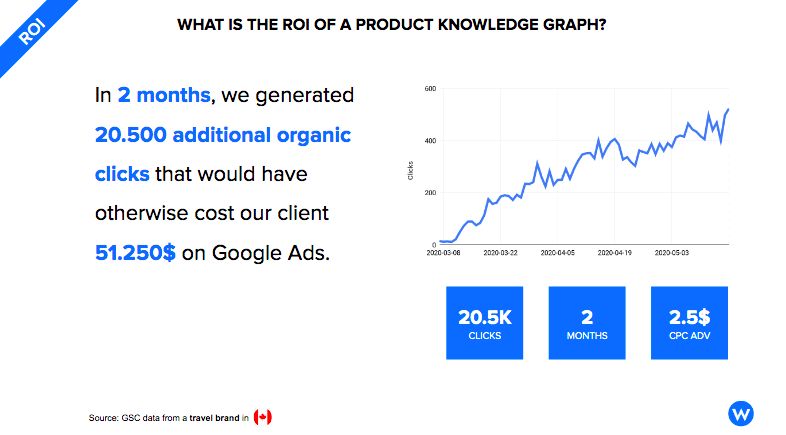Executive summary:
This post is part of a series that dives deep into the power of data for e-commerce. You can find the other posts here:
- The Power of Product Knowledge Graph for E-commerce
- Touch your SEO: Introducing Physical SEO
- The GS1 Digital Link explained for SEO Jedis (and their clients)
- The Only Thing Missing in Your Omnichannel E-commerce Strategy is…
In this updated post, part of our Product Knowledge Graph Series, we delve deeper into the evolving landscape of search engine optimization, highlighting the pivotal role of GS1 Digital Link and product page optimization for e-commerce websites. Building on our previous insights, we now incorporate key takeaways from the 2024 edition of the Global Forum and insights from Andrea Volpini’s enlightening presentation on leveraging GS1 Web Standards in SEO. This post aims to equip you with a comprehensive understanding of the next frontier in SEO and how GS1 Digital Link serves as a cornerstone for optimizing e-commerce product pages.
The digital age continues to redefine SEO practices, making it crucial for businesses and individuals to stay abreast of the latest trends, research, and applications. The GS1 Digital Link standard emerges as a game-changer, offering a seamless way to connect consumers with precise product information, thereby enhancing the online shopping experience.
- What is GS1 Digital Link and Why Is It Important for SEO?
- How GS1 Digital Link Works – Insights from the 2024 Global Forum
- Leveraging GS1 Web Standards in SEO
- How Can You Use GS1 Digital Link for SEO
- Enhancing E-commerce Page Optimization with GS1 Digital Link
- GS1 Digital Link as only the Tip of the Iceberg called Product Knowledge Graph
- GS1 Digital Link Quick Reference for Your Next Client
- Conclusion
What is GS1 Digital Link and Why Is It Important for SEO?
GS1 Digital Link (GS1 DL) is a descendant of the well-known barcode but can carry much more data than its antecedent. And this alone reduces the need for multiple codes on a pack. Something more, GS1 DL provides a standard way of expressing data in a format that can be used on the Web, which can directly put a product through its barcode in a linked environment.
Case in point, a GTIN (the unique product identifier that provides accurate and rich product information to Google, Bing and other marketplaces) can be encoded into a Web address, following GS1 Digital Link standard specifications. The latter is essential, as GS1 standards are the most widely used system of standards in the world, much like W3C are, and with them, anyone can convert a GTIN into a web address.
How GS1 Digital Link Works – Insights from the 2024 Global Forum
So here is how GS1 Digital Link works.
Let’s look at “Dal Giardino Extra Virgin Olive Oil Exclusive Selection” as a reference product. Its unique product identifier is GTIN 9506000134369, which corresponds to a GS1 barcode that you will find printed on its bottle label. Using this unique ID we can obtain its web address https://id.gs1.org/01/9506000134369. Now this one looks like a normal URL, but it’s a linked data URI instead and can:
- Redirect the end-user to the product information page
- Provide structured information about the olive oil that machines like Google understand (using schema.org or GS1 Web Vocabulary)

Technically speaking, GS1 digital link specifications express GTINs as URLs. Also, GS1 Digital Link is an element of the structured data pack in https://schema.org/Product and provides the structure for information about a product, such as expiration dates, nutritional and medical product data, warranty registration, troubleshooting instructions, even social media links.

It is important for SEO because with GS1 Digital Link, as with any unique identifier, the product URL and Unique Identifiers are separated, meaning together with the web page, a URI contains all the data good for the crawlers separated from the page.
Case in point, visual search.
Insights from the 2024 Global Forum
The 2024 Global Forum was a pivotal event for understanding the advancements and practical applications of GS1 Digital Link in SEO and e-commerce optimization. During this forum, Andrea Volpini shared invaluable insights into how GS1 Digital Link is revolutionizing how we think about product data on the web.
GS1 Digital Link extends the power of traditional barcodes by transforming them into gateways to a wealth of online information about a product. Unlike conventional barcodes limited to storing a product’s Global Trade Item Number (GTIN), GS1 Digital Links can connect consumers and search engines directly to dynamic online content. This could include nutritional information, user manuals, social media pages, and even augmented reality experiences, all accessible through a single scan.
Leveraging GS1 Web Standards in SEO: Key Takeaways from Andrea Volpini’s Presentation
Andrea’s presentation at the 2024 Global Forum highlighted several key points:
- Seamless Integration: GS1 Digital Link seamlessly integrates with existing web technologies, making it easier for brands to connect their physical products with their online presence. This integration enhances the visibility of products in search engines, contributing to more effective SEO strategies.
- Enhanced Consumer Experience: By providing direct access to a wide array of product-related content, GS1 Digital Link significantly improves the consumer experience. This direct engagement boosts brand loyalty and increases the chances of conversion.
- Visual Search Optimization: Andrea emphasized the role of GS1 Digital Link in optimizing for visual search, a rapidly growing area in SEO. With smartphones increasingly recognizing products through cameras, GS1 Digital Link ensures that products are readily identifiable and linked to relevant online content.
- Future-Proofing SEO: Adopting GS1 Digital Link is a step towards future-proofing SEO strategies. As search engines evolve to prioritize direct, meaningful connections between physical products and their digital counterparts, GS1 Digital Link positions brands at the forefront of this shift.
Incorporating these insights from the 2024 Global Forum, it’s clear that GS1 Digital Link is not just a tool for enhancing product visibility online; it’s a comprehensive strategy for bridging the gap between the physical and digital worlds, ensuring that products are discoverable, engaging, and relevant in the ever-evolving landscape of search.
How Can You Use GS1 Digital Link for SEO
In the evolving landscape of search engine optimization, the emergence of visual search has marked a significant shift, particularly in e-commerce. As highlighted by Semrush, visual search engine optimization is becoming increasingly important, with mobile devices playing a pivotal role in the consumer shopping journey. Recent studies indicate that 62 percent of consumers strongly prefer visual search capabilities, underscoring the need for swift and intuitive product discovery and identification on mobile platforms.
Visual search caters to users’ immediate needs and enhances the overall shopping experience by seamlessly integrating with GS1 Digital Link standards. This integration offers a more direct and informative approach to product identification. Unlike traditional search methods, where users may scan an item with Google Lens and sift through various results, GS1 Digital Link enables a single scan of a product’s barcode to unlock a comprehensive product information network. This streamlined process facilitates instant access to detailed product data, thereby simplifying the decision-making process for consumers.
The application of GS1 Digital Link extends beyond visual search, offering substantial benefits for e-commerce page optimization. By leveraging GS1 Digital Link, businesses can ensure that their product pages are optimized for search engines and equipped to meet modern consumers’ evolving expectations. This approach enhances visibility and discoverability and contributes to a more connected and informative online shopping environment.
Two Visual Search Scenarios:
- Traditional Visual Search: Users encounter a product of interest, use Google Lens to scan it, and navigate through various search results to find relevant information.
- GS1 Digital Link Enhanced Search: Users scan the barcode of a product using GS1 Digital Link, instantly accessing a wealth of specific information about the product, streamlining the search and discovery process.

The integration of GS1 Digital Link into visual search and e-commerce optimization strategies represents a forward-thinking approach to meeting the demands of the digital consumer, ensuring a more efficient, informative, and satisfying shopping experience.
Enhancing E-commerce Page Optimization with GS1 Digital Link
As Aleyda Solis aptly advises:
“Our goal with category pages should be then to feature information that confirms the features/functionalities/USPs of that particular set of products, clarifies any common doubts about them, informs about any existing offers and why/how the user is in the best place to buy them, as a salesperson would do at a physical store at that point in the customer journey.”
(Cit. Optimizing Content in Category Pages while Keeping its Commercial Nature)
Now add to that some algorithmic power a GS1 Digital Link. The content for category and product pages will serve the user’s intent and, on top of it, provide them with a richer than expected experience by serving machines what they want – clean and structured data.
Further, once connected these data can be accessed via the GS1 Digital link, that is from any store through a scan, given there is a barcode on the product.
Optimizing content with markup will also allow Google and other search engines to populate search features, such as product Knowledge Panels or Google’s mobile Popular Products carousel. And what is more important in the age of entity-based search: create connections within the Knowledge Graph for easier entity recognition.
The more structured data we enrich content with, the better we will serve the transaction experience by readily providing information about prices, availability, reviews, videos, accessories, and other product details.
GS1 Digital Link as only the Tip of the Iceberg called Product Knowledge Graph
“For My Ally is the DATA, and a Powerful Ally It Is.”
Just like structured data became a thing for SEO with the introduction of Google’s Knowledge Graph and gained popularity as more SEO professionals began helping online retailers leverage unique identifiers and structured data, these days another tool for greater visibility in search and quality traffic is on the way – the product knowledge graph. It is one way to approach structured data in a novel way from an SEO perspective.
Put simply, a Product Knowledge Graph is an e-commerce specific form of knowledge graph built to improve product findability and end-user experiences by enriching a brand’s content with data. Made of structured data and extended product markup, injected across both editorial and product content, a product knowledge graph is built on top of the product database to link all data together combining both structured information, (for instance, the list of products for a brand) or unstructured (for example the descriptions related to a collection of products).
Structured DATA and GS1 Digital link can be part of this product knowledge graph, playing an important role in better customer experience and richer results.
Structured data binds the data about products, brands, product categories, product features, reviews, hi-resolution images, shipping data, FAQs and a lot more. And GS1 Digital Link just serves as the portal to this ecosystem of product information. As a standard, it helps us bring the data (in the product knowledge graph) into the end user’s hands.
In the example below, you can see what a product knowledge graph can render in terms of rich results across a number of Google services.

This pretty much is product-graph powered SEO – it is about enriching the content about an entity with a cluster of other entities and pages.
Read our e-commerce SEO case study to learn more about the results you can achieve by building a Product Knowledge Graph for your website.
To use the table we used and the visual search scenarios, creating your own product knowledge graph is the other logical step. And it can be taken by using the GS1 Digital Link. And that is enriching the network of data with more connections – a structured data in your physical product code included.

More on Product Graphs and Joe (the hyperconnected customer using them) is available here.
GS1 Digital Link Quick Reference for Your Next Client
To circle back to the coal mine metaphor (i.e. helping people find diamonds without dirtying themselves in the coal), SEO is all about finding ways to give readily structured precious pieces of data to search engines. And as SEO is turning to data graphs, (as Bill Slawski put it “The Web as a data is the new direction for SEO), the better the data, the more valuable diamonds.
On the Web, better data means highly-connected data. And this is what SEO professionals have been doing – weave content, data and links together to connect the dots (actually, the nodes) for crawlers and ultimately get more sophisticated data to appear in search results.
However, with the ever-increasing sophistication of search engines, the time has come to add another element to the SEO value proposition. The SEO community now is to communicate to potential and existing clients the mission-critical role of links between data to the talk about why keywords, content, relevancy matter and traffic.
To help spread the word about the Web of data and SEO’s role in it, we created this list as an executive summary for the client who needs more context for your next SEO move.
- What is structured data and what is GS1 Digital Link?
Structured data is data that describes objects in a formal way. On the Web it is used to mark up pages, one of the most popular standard for markup being schema.org. In Plain English, it is this thing that makes types of snippets like review, recipe, video, and news article snippets appear when you search for something on the Web. Read Our Web Story.
GS1 Digital Link provides the standards-based structure for the data about a product. GS1 Digital Link carries information such as expiration dates, nutritional and medical product data, warranty registration, troubleshooting instructions, even social media. In Plain English, this is a barcode that can carry tons of connected data. Read Our Article.
- How structured data and GS1 Digital Link benefit SEO?
People scan, search, compare, look for all kinds of data on the Web. The more structured and granularly linked these data are, the more visible and easy to digest they are by people’s (serch engines, apps, APIs and assistants – think Google, Alexa, Google Merchant centre)
- Give me the numbers [Gimme ROI]
1. Increased Google Real Estate for 2 months.

2. In 2 months, we generated 20.500 additional organic clicks that would have otherwise cost our client 51.250$ on Google Ads.

Check more numbers from structured data success stories here .
Conclusion
As we’ve explored, GS1 Digital Link is not just a tool but a game-changer in the SEO and e-commerce landscape. The 2024 Global Forum has illuminated its potential to revolutionize how products are discovered and engaged with online. Armed with these insights, SEO professionals and digital marketers are better equipped to navigate the future of search engine optimization. Embrace the power of GS1 Digital Link and propel your e-commerce strategies into a new era of visibility and success.
WordLift can help you build your product knowledge graph. Let us show you how. Book a call with our team of experts.
Must Read Content
The Power of Product Knowledge Graph for E-commerce
Dive deep into the power of data for e-commerce
Why Do We Need Knowledge Graphs?
Learn what a knowledge graph brings to SEO with Teodora Petkova
Generative AI for SEO: An Overview
Use videos to increase traffic to your websites
SEO Automation in 2024
Improve the SEO of your website through Artificial Intelligence
Touch your SEO: Introducing Physical SEO
Connect a physical product to the ecosystem of data on the web
